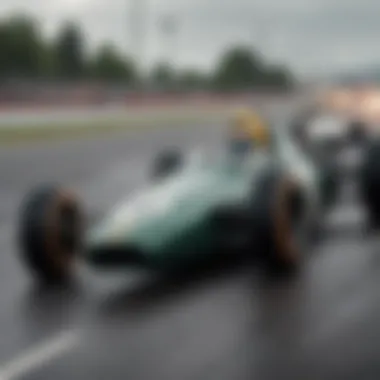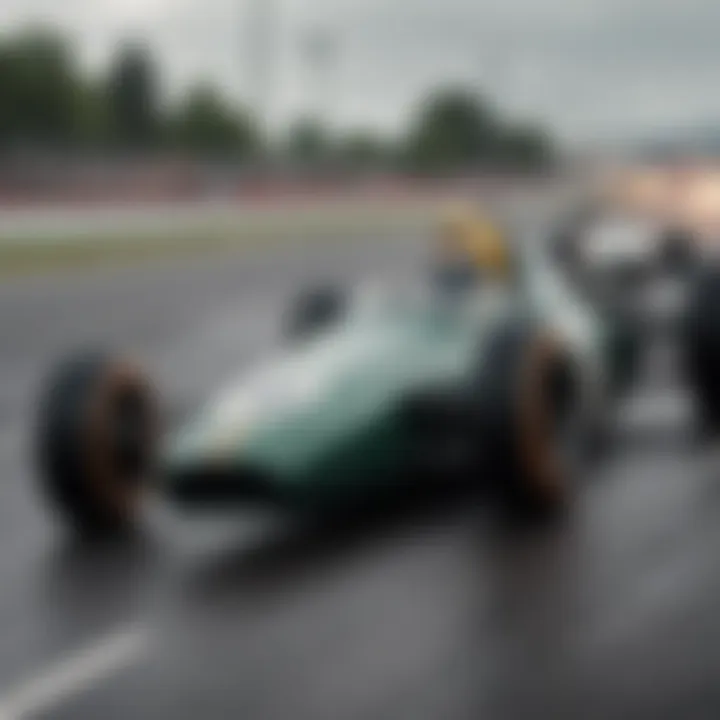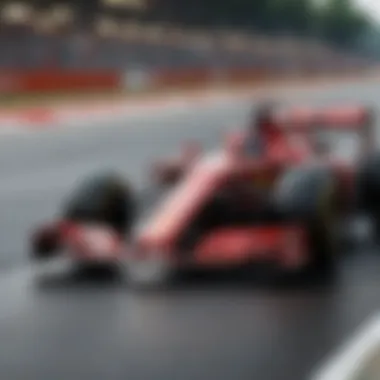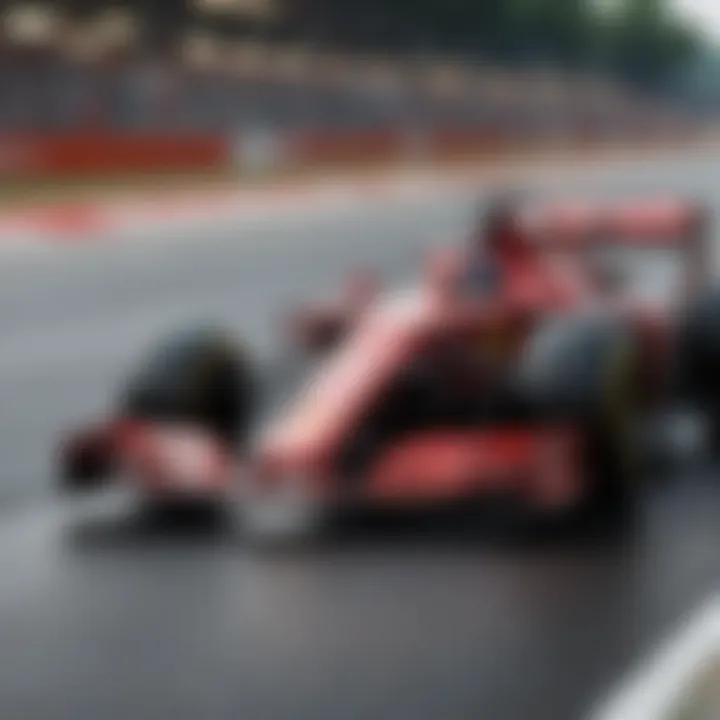Exploring the Intricacies of Formula One Tracks


Intro
Formula One racing isn't just about the thundering engines and the skilled drivers; it's about the intricate tracks that challenge teams and excite fans. As one journeys through the world of Formula One, each circuit tells its own story woven from history, technology, and design. But what factors make these tracks the unique battlegrounds seen on screens around the globe? From hairpin turns to fast straights, each curve and elevation introduces a fresh dimension to strategy and performance.
In this exploration, we’ll dive deep into the essence of Formula One tracks. We’ll navigate crucial elements such as the design principles that govern their layouts, the tech advancements steering their evolution, and the historical narratives that surround them. This article aims to bring you face-to-face with the multifarious qualities that make Formula One circuits icons in their own right. Let’s buckle up for this ride through the asphalt jungle!
Prelims to Formula One Tracks
Formula One racing is much more than just the speed and skill of drivers behind the wheel; it's a complex dance between cars and the meticulously designed tracks they race on. These circuits are not mere stretches of asphalt; they embody historical narratives, engineering triumphs, and the very essence of motorsport culture. Thus, understanding Formula One tracks is not only beneficial for fans but crucial for anyone wanting to grasp the intricacies of this high-octane sport.
Definition and Importance
When we refer to Formula One tracks, we talk about specialized circuits where the thrilling races take place. Each of these tracks presents its own unique challenges—be it sharp curves, elevation changes, or varied surface materials. The importance of these tracks lies in how they shape race weekends; the design of a circuit can make or break a driver's performance. Most importantly, they influence race strategies, pit stops, and even overall safety measures in place for competitors. Their layouts encourage close racing and can lead to either exhilarating overtakes or chaotic collisions, both of which captivate audiences around the globe.
To give an idea of how pivotal these tracks are, consider this: each circuit often becomes a character in its own right, boasting its own history and quirks. For instance, the technical demands of the Monaco Grand Prix are legendary, while the fast and flowing nature of the Silverstone Circuit caters to those who challenge their cars to the limits.
Historical Overview
Diving down the annals of Formula One, the emergence of tracks can be traced back to the early decades of the sport. It’s fascinating how tracks have evolved with time—from the rudimentary road courses of the 1950s to the technologically advanced circuits today. Initially, races often took place on public roads, a scenario that lent an air of unpredictability to the races.
As safety regulations tightened and technology improved, purpose-built tracks began to sprout across the globe. For example, the Circuit de Monaco has been a fixture since 1929, marrying the charm of the narrow, twisty streets with the glamour of Monte Carlo. Meanwhile, more modern tracks, like the Circuit of the Americas, have been designed with state-of-the-art safety features and audience engagement in mind.
What sets these tracks apart is not only their design but the legendary races that have unfolded upon them. Each turn, each straight has witnessed remarkable moments—be it Ayrton Senna's memorable laps or the nail-biting finishes that keep fans on the edge of their seats. In essence, the historical context of these tracks enriches our understanding and appreciation of Formula One, forging a deeper connection between the sport and its aficionados.
"The character of a track can turn a good driver into a great one, creating legends of the sport on the very terrain they rally upon."
Track Design Fundamentals
Understanding track design is key to appreciating the phenomenal world of Formula One racing. Each circuit embodies not just a layout but a rich interplay of science, engineering, and artistry that culminates in unforgettable racing experiences. The intricate elements of track design, carefully considered by architects and engineers alike, serve to influence everything from speed to safety. In this section, we will delve into the dimensions of layout considerations and safety features, both fundamental to the formation of a truly exceptional circuit.
Layout Considerations
Curvature and Straightaways
Curvature and straightaways are hallmarks of any racing track. A well-designed balance between these two elements can make or break a circuit's character. Curves, ranging from gentle arcs to hairpins, challenge drivers to master precise handling, making this aspect incredibly engaging. These curves can create overtaking opportunities, as drivers maneuver their machines at high speeds while battling centrifugal forces.
Straightaways, on the other hand, are the moments of pure acceleration, where drivers unleash the full power of their engines. They are the spine of a track, often allowing for strategic overtaking maneuvers. For instance, the long straights found at Monza are not just for show; they play a crucial role in race dynamics, contributing to numerous jaw-dropping moments.
However, a mix that's too lopsided can result in a bland or overly dangerous track. Too many turns can lead to congestion, while extended straight sections may cause accidents as drivers push limits. Hence, finding that sweet spot becomes essential in track design, making curvature and straightaways pivotal aspects worth deliberating.
Elevation Changes
Elevation changes add an extra layer of complexity to race circuits. Tracks that feature varied terrain force drivers to constantly readjust their approach, particularly through blind crests and descents. The steep climbs seen at Spa-Francorchamps are not just a punishing experience; they enhance a circuit's visual appeal and create opportunities for dramatic moments, such as daring overtakes or stunning undercuts.
Moreover, these changes oftentimes dictate braking points and acceleration timing, meaning that graduates of track analysis must factor them into their racing strategies. However, the downside is that extreme elevation variations may end up increasing the risk of accidents, particularly if rain or other unfavorable weather conditions blanket the track. Yet, when executed sensibly, these elevation changes lend a track a unique flavor, setting it apart from other circuits.
Pit Lane Configuration
The layout of the pit lane bears significant importance in the world of Formula One. For one, its proximity to the main track influences strategies for both pit stops and race tactics. An efficiently designed pit lane facilitates smooth, quick stops that can greatly impact race outcomes. Any delays in this zone can spell disaster for teams passionate about their performance.
Moreover, some configurations incorporate creative features such as dual pit lanes or strategic zones to minimize the risk of collisions during pit stops. For instance, pit entry and exit must be separated from racing lines to ensure that drivers don't collide with those leaving or entering the pits. While some configurations have garnered criticism for their complexity, a well-thought-out pit lane can distinguish a successful track from its competitors.
Safety Features
Barriers and Run-off Areas
Safety has become paramount in Formula One, and this focus heavily influences track design. The positioning of barriers and the design of run-off areas are critical to alleviating potential risks during races. Modern tracks employ high-tech barriers made from materials like Energy Absorption Systems, significantly reducing impact forces. These barriers effectively absorb kinetic energy, which can protect drivers during high-speed collisions.
On the flip side, correctly designed run-off areas provide drivers a safe zone to regain control should they lose their grip or make a mistake. However, if these zones are poorly designed, such as being too narrow or filled with gravel, they can exacerbate instead of alleviate the situation.
Escape Routes
Another vital safety consideration is the inclusion of escape routes. These are designed to give drivers a safe path off the main circuit in case they lose control. Well-planned escape routes can significantly reduce the risk of accidents, as they allow veering vehicles to slow down before hitting an obstacle. The good news is that incorporating escape routes into a track layout generally enhances safety without sacrificing the excitement of high-speed racing.
While this concept is widely accepted, designers must strike a balance. An escape route that is too wide might attract drivers looking to overtake in risky ways, leading to collisions or other incidents. Hence, a thoughtful approach to designing escape routes is essential.
Impact Absorption Technologies
The advancement of impact absorption technologies in track design plays a pivotal role in protecting drivers and enhancing their safety. Systems like energy-absorbing barriers and soft walls are specifically engineered to mitigate the forces felt by vehicles during collisions. These innovations are driven by ongoing research, aiming to reduce injuries stemming from high-speed accidents.
Yet, the implementation of such technologies sometimes faces resistance, mostly due to costs and logistics. Not every track has the capacity for substantial upgrades, particularly older circuits. However, as the sport evolves, the call for integrating more of these technologies becomes louder. This will be crucial for meeting new safety standards while preserving the thrill of racing for which these circuits are renowned.
Iconic Formula One Tracks
In the realm of Formula One racing, few elements can rival the impact of iconic tracks. These circuits are not just mere pathways for fast cars, but the backbone of the sport's history and culture. Each track holds its own identity, stemming from its unique layout, geographical features, and the challenges it presents. By focusing on these iconic Formula One tracks, we understand not only the technical aspects of racing but also the emotional connections that drivers and fans alike feel toward them.
Monaco Grand Prix Circuit
Street Circuit Characteristics
The Monaco Grand Prix Circuit is often considered the epitome of glamour and prestige in Formula One. Its street circuit characteristics set it apart, making it a bucket-list event for any racing enthusiast. The narrow and winding streets, framed by luxurious yachts, create a sense of exclusivity. One key aspect of this circuit is the tight corners, which demand precision and skill from the drivers. Notably, the lack of run-off areas puts a premium on accuracy, leaving no room for error. This characteristic not only contributes to thrilling racing but also amplifies the excitement among spectators.


However, the very nature of street circuits also presents challenges. The surface often varies due to urban wear and tear, leading to changing grip levels. These fluctuations can be a mixed bag; while they add unpredictability to the race, they also heighten the risk for drivers, making each lap a true test of nerve and ability.
Challenges Faced by Drivers
Monaco’s unique setup creates a myriad of challenges for drivers. One notable challenge is the limited overtaking opportunities, which makes it difficult to gain positions during the race. This characteristic places immense pressure on drivers not only to qualify well but also to maintain their position throughout the event. The physical demands of racing through such tight confines can push even the most seasoned pros to their limits.
Moreover, the elevation changes throughout the course complicate matters. Drivers must constantly adapt their braking and acceleration points, as the car dynamics shift with the steep inclines and declines. Ultimately, the challenges faced at the Monaco circuit are a test of skill and strategy, making it a defining moment in a driver’s career.
Historical Races and Moments
Over the decades, Monaco has witnessed some of the most riveting moments in Formula One history. The uniqueness of the circuit has led to numerous legendary races and unforgettable incidents. For instance, the 1982 race is infamously remembered for its chaos, where multiple drivers encountered mishaps, resulting in an unexpected win for the late Riccardo Patrese.
Such historical significance not only adds layers to the circuit's allure but also fosters a rich narrative that resonates with fans. Each race contributes to the legacy of Monaco, marking it as a must-watch event on the Formula One calendar.
Silverstone Circuit
Significance in Formula One
Silverstone Circuit, the birthplace of Formula One, holds substantial importance in the sport’s identity. Hosting the very first Formula One race in 1950, it has become a symbol of racing heritage. The significance of Silverstone extends beyond its historical roots; it has evolved into a prime venue that regularly incites high competitive spirit.
Its flat terrain combined with a high-speed layout offers a thrilling experience for drivers and fans alike. The blend of fast straights and technical corners tests the capabilities of the cars and the expertise of the racers. This duality forms the essence of what makes Silverstone a constant fan favorite.
Technological Advances at Silverstone
As time marches on, Silverstone has remained at the forefront of technological advancements within the sport. Not only has the circuit itself been upgraded to meet current safety standards, but it also hosts various tech-related initiatives that engage teams and fans.
One significant feature is the introduction of hybrid technology integration in recent years. This advancement enhances performance and efficiency, aligning with the sport's broader push towards sustainability. As the track embraces these innovations, it continuously reshapes the experience for drivers and spectators alike, ensuring that it remains relevant in a fast-evolving landscape.
Fan Engagement and Experience
Silverstone excels in promoting fan engagement, making it more than just a race venue. The track offers unique experiences, including behind-the-scenes access and interactive zones that allow fans to delve deeper into the world of Formula One.
This commitment to fostering engagement translates into a more dynamic atmosphere, where fans feel a tangible connection to the events unfolding on track. However, this dedication to the fan experience comes with operational challenges, as the venue must accommodate increasing numbers without compromising quality.
Spa-Francorchamps
Challenging Conditions
Few tracks evoke as much reverence as Spa-Francorchamps. Nestled in the Ardennes, its challenging conditions create a formidable playground. Renowned for its unpredictable weather, drivers often face rain in one sector while enjoying dry conditions in another. This variability requires not only top-notch driving skills but also adept strategic thinking.
The challenges posed by this dynamic environment can be a double-edged sword. While the uncertainty keeps fans on the edge of their seats, it can also be deeply frustrating for teams aiming for precision. The fluctuating conditions make Spa a true test of mastery in motorsport.
Famous Corners and Sections
Spa’s reputation is partly anchored in its iconic corners, such as Eau Rouge and Raidillon. These sections demand precision and bravery from drivers. Navigating them at full throttle is a point of pride, but it also showcases the fine line between skill and recklessness.
The unique geometry of these corners enables drivers to showcase their prowess, often leading to breathtaking overtakes and defining moments in races. Clubs and online communities resonate with these conversations, elevating the allure of Spa.
Notable Races and Outcomes
Spa-Francorchamps has soared to fame through remarkable races that have shaped seasons and careers alike. A particularly noteworthy event took place in 1998, where a downpour led to an unforgettable race, showcasing the chaos and unpredictability that Spa is known for.
This narrative of dramatic outcomes binds its history, adding richness to the track's legacy. Everyone recalls races that led to stunning victories or heart-wrenching defeats, etching deep emotional imprints in the minds of fans.
Through this exploration of iconic tracks, the narrative surrounding Formula One becomes vibrant, allowing enthusiasts and potential fans to appreciate the complexity and excitement of each race. Tracks like Monaco, Silverstone, and Spa each tell their own story, enriching the overall tapestry of Formula One racing.
Technological Innovations in Track Construction
In the high-octane world of Formula One, the importance of track construction cannot be overstated. Technological innovations in this domain have brought an era that not only enhances performance but also prioritizes safety and sustainability. Developments such as advanced materials, sophisticated data analysis, and design simulations are changing the making while enriching the racing experience. What goes into building these circuits often determines their character, safety, and operational efficiency.
Materials and Techniques
Asphalt Composition
Asphalt is the lifeblood of any racing circuit. The composition of asphalt directly affects grip, durability, and the tire interaction. In a typical Formula One track, the gradation of aggregates, the type of binder, and the presence of additives play significant roles. A high-performance asphalt mix often includes polymer modifiers, which enhance flexibility and reduce wear on tires. This makes it a preferred choice as it provides a balance between grip and longevity.
However, it isn’t entirely without woes. While the benefits are quite substantial, like improved tire integrity, they come with costs for maintenance and expert analysis during application. The unique feature here is that manufacturers can tweak the mixture according to the climate and other environmental conditions, which helps in managing things like heat levels effectively.
Drainage Systems
Effective drainage systems are critical in Formula One tracks. They manage rainwater, preventing pooling that could lead to accidents or poor racing conditions. An efficient drainage system often incorporates permeable materials and sloped surfaces that redirect water away swiftly. This choice is vital, especially in regions with unpredictable weather.
The unique trademark of modern systems includes integrated channels and sump pits that ensure a quick runoff. However, if not maintained properly, these systems can fail, leading to dangerous conditions. A sound drainage setup protects racers while maintaining the track's integrity.
Surfaces for Optimal Grip
Tracking conditions often dictate race strategy; hence, surfaces designed for optimum grip are essential. Various treatments are applied to the asphalt, such as gravel sealants or texturing techniques, to enhance friction. A key characteristic of surfaces for grip is their ability to maintain tire temperature. If a driver’s tire overheats, it can lose grip, leading to a disappointing performance at critical times.
The distinguishing feature is that some surfaces can provide a consistency that is predictably favorable across different temperatures and conditions. Nevertheless, these surfaces can also experience excessive rubber buildup during races, leading to inconsistent grip levels unless closely monitored and managed.
Data Analytics and Simulation
Track Performance Analysis


Data analytics has made its way into track management, drastically changing how circuits are analyzed. Comprehensive performance analysis includes metrics like lap times, tire wear, and vehicle speed at various track sections. This allows engineers to dissect race data with surgical precision and make adjustments accordingly.
A key aspect of performance analysis is its predictive nature. Teams can anticipate how changing track conditions will affect race dynamics. However, this doesn’t come easily; the technology is costly and requires sophisticated expertise. Yet the benefits—enhanced safety and improved race strategies—are irrefutable.
Simulated Driver Experience
Simulations have become a staple in driver preparation, allowing racers to experience the track virtually before they set foot on it. This includes understanding various complexities such as cornering angles and elevation changes. The simulated driver experience gives insights into how different cars react under varying conditions, making it an invaluable tool.
The key to the success of this technology lies in its intrinsic ability to mimic real-life scenarios, potentially saving teams countless hours of practice. One downside, however, is the potential disconnect between simulated performance and actual track dynamics, which can lead to surprises come race day.
Predictive Modeling for Safety
Predictive modeling encompasses a wide array of factors, including environmental changes and circuit wear over time. By utilizing historical data, engineers and safety teams can forecast possible scenarios and implement designs that mitigate risks effectively.
The core appeal of predictive modeling is its ability to suggest adaptive safety measures as new data comes in. This anticipatory aspect can mean the difference between a standard run and one that preemptively addresses potential hazards.
However, the reliability of models depends heavily on the quality of data input. If the data is flawed or incomplete, it might lead to catastrophic consequences. Yet, as technology evolves, the predictive models are becoming increasingly accurate, which is encouraging for future circuits.
By leveraging these technological innovations, Formula One tracks are not just about speed; they're about evolving to meet safety standards and enhancing performance, setting benchmarks in the world of motorsport.
The Role of Weather and Environment
Understanding the dynamics of weather and environmental factors is crucial in the context of Formula One racing. Each race is not just a contest of speed; it's a game of strategy often heavily influenced by unpredictable weather conditions. Elements like temperature, humidity, and even the likelihood of rain can change how teams strategize, including tyre choices and fuel management. These aspects can determine the winner or cause a top contender to crash and burn—sometimes literally. It's essential to recognize that planning effectively around these factors can be just as important as having the fastest car on the grid.
Impact on Race Strategy
Tire Choices
Tire choices are a linchpin in the intricate machinery of race strategy. Teams must select from various compounds, each designed for specific conditions—some grip fiercely in warm weather, while others excel in the wet. The key characteristic of tires is their rubber compound, and the choice often hinges on track temperature and atmospheric conditions.
The unique feature of tires like the soft compound is their ability to offer superior grip but at the expense of durability. This can be a double-edged sword during long races; when the skies open up, the performance can plummet if you haven't chosen wisely. Hence, understanding how tire performance varies with temperature and surface moisture is vital for success.
Fuel Management
Fuel management can make or break a team's performance over the course of a race. It requires strategists to decide not just how much fuel to start with but also how to utilize it effectively throughout the race. The key characteristic of effective fuel management is optimizing consumption without sacrificing speed, a delicate balance that demands constant adjustments based on race conditions.
One notable feature is that different weather conditions can radically alter fuel efficiency. For instance, a cool day might allow cars to run lean, conserving fuel while still competing at high speeds. However, on a scorching day, teams may need to alter their fuel strategies to avoid overheating the power unit, showcasing both the advantages and disadvantages of flexible fuel management in racing.
Weather Forecasting Tools
The advent of technology in predicting weather patterns has transformed the way teams strategize for races. Weather forecasting tools have become indispensable in shaping race day decisions. The key characteristic of these tools lies in their ability to provide real-time data, allowing teams to adapt instantaneously to changing conditions.
An exceptional feature of these tools is the granular level of detail they offer. For example, in a situation where rain is imminent, teams can quickly switch their tire strategy from slicks to intermediates or even wet tires. The advantage here is clear: accurate forecasting can give a team a competitive edge, but it also comes with the risk of overreliance on potentially inaccurate predictions.
Long-term Environmental Considerations
Amid ongoing discussions surrounding climate change and environmental sustainability, Formula One is increasingly mindful of its long-term impact on the environment. The ongoing scrutiny of ecological footprints means that track management and race organization extend beyond the immediate needs and delve into the broader implications on community and nature.
Sustainability Practices
Sustainability practices are becoming integral to Formula One tracks globally. From utilizing eco-friendly materials in track construction to implementing water conservation measures, teams and organizers are more conscious than ever about their environmental impact. The key characteristic of these practices is a commitment to reducing waste while ensuring that the sport remains engaging for fans. Unique features include the advent of biofuels and the use of hybrid technology aimed at minimizing carbon footprints. While sustainability practices are beneficial for public relations and long-term viability, they can also incur initial costs that may stall progress for some teams until they see the returns on their investments.
Community Engagement
Community engagement is also a significant factor in the long-term planning of Formula One tracks. Effective engagement turns racing into a local phenomenon, allowing communities to take pride in their association with a globally popular sport. The key characteristic here is the interaction between the teams and the local populace. Local initiatives, whether through educational programs or environmental awareness campaigns, show that teams are not just visitors but are invested in their surroundings. The unique feature of these engagements is that they build a sense of belonging within local communities. On the flip side, mishandled relationships can lead to public discontent, somewhat detrimental to the sport's reputation.
Impact on Local Ecosystems
The impact on local ecosystems is both a concern and a responsibility that Formula One tracks must consider. The key characteristic of this aspect is the potential disruption race events can cause to natural habitats. Track design and construction can have lasting effects on wildlife and plant life within the vicinity. While many organizers now monitor local ecosystems closely, ensuring that biodiversity is preserved is not always straightforward. The unique feature is that some tracks even work to restore and protect local habitats as part of their operational efforts, which is a significant win for both the community and nature. However, this adds layers of complexity to track management.
"The integral relationship between weather, environment, and Formula One race strategy underscores how crucial it is for teams to remain adaptable and conscious of their surroundings."
Overall, understanding the multifaceted role of weather and environmental factors not only enriches the spectacle of Formula One but also galvanizes teams and fans alike toward greater ecological consciousness.
Challenges in Formula One Track Management
Managing Formula One tracks is akin to steering a finely tuned race car through a series of tight turns and sudden obstacles. The complexities involved go well beyond the mere configuration of asphalt and barriers. Factors such as maintenance, economic viability, and operational logistics play crucial roles in ensuring that these high-octane venues are up to standard for both drivers and audiences alike.
Maintenance and Upgrades
In the world of Formula One, regular maintenance and upgrades are not just best practices—they are necessities. Keeping a track in top-notch shape can spell the difference between a successful Grand Prix and one that falters under poor conditions.
Regular Inspections
Regular inspections are vital in track management. This practice involves systematic assessments of the track's surface, safety barriers, and overall infrastructure. The key characteristic of these inspections is their frequency; they happen more often than one might expect, sometimes even before every race weekend. It’s about catching issues before they snowball into major problems.
Regular inspections offer several advantages. They allow for early detection of wear and tear, ensuring the track remains safe for high-speed racing. However, they do come with their downsides. The inspections can lead to temporary closures, inconveniencing drivers and teams who rely on the time for practice and calibration of their vehicles. Not to mention, the costs associated with these inspections can add up, impacting the overall budget.
Repaving Techniques
Repaving techniques are another essential element in maintaining Formula One tracks. Tracks need resurfacing every now and then to deal with the wear inflicted by high-speed traffic. The main characteristic here is the material used—specifically, the type of asphalt chosen. Superior materials like polymer-modified asphalt ensure a smoother ride and better grip.
This unique feature of repaving plays a big role in track performance. By using cutting-edge materials and techniques, track managers can improve safety and enhance driver experience. On the flip side, the process is resource-intensive. From sourcing materials to setting aside time for the actual work, repaving can be a logistical nightmare if not planned appropriately.
Infrastructure Improvements
Infrastructure improvements encompass a variety of upgrades, from better signage to enhanced safety barriers. These enhancements contribute significantly not only to driver safety but also to fan experience—ensuring visibility and accessibility during races. One of the key characteristics of infrastructure improvements is their ability to adapt to new safety regulations or technological innovations.


A unique feature of these improvements is their dual focus; they cater to both operational needs and spectator experience. For instance, upgrading viewing areas for fans can enhance engagement and make the event more enjoyable. However, this often involves significant investment and time, which can strain budgets.
Economic Factors
Economic factors are a constant backdrop in the management of Formula One tracks. From securing funding to navigating the complexities of sponsorships, financial viability is a significant concern.
Funding Challenges
Funding challenges are significant hurdles for track management. Securing the necessary resources can impact the level of maintenance and upgrades achievable. The characteristic challenge lies in aligning the funding source with the goals of the track—whether that be for safety improvements or aesthetic upgrades.
The unique feature of funding challenges often revolves around the unpredictability of financial backers. Sponsorship deals come and go, and what seemed like a solid plan can dissolve overnight, leaving track managers in lurch. This uncertainty can complicate long-term planning and improvements, as sudden funding shortfalls can delay essential work.
Sponsorship Influence
Sponsorship influence direct impacts on track management budgets. Many tracks rely on the financial backing of automotive brands and other sponsors to keep operations smooth. The key characteristic here is the dependence on sponsor visibility and return on investment for sponsors.
From naming rights to advertisements on-site, sponsorship influence can also dictate aspects of track management. While sponsor influence can lead to significant funds for upgrades, it can also constrain decisions if sponsors' interests differ from track management goals. Finding the balance between brand presence and track integrity poses an ongoing challenge.
Operational Costs
Operational costs are the bread and butter of track management discussions. Everything from staffing to utilities contributes to the bottom line. A key characteristic of operational costs is their predictability—yearly budgets can be forecasted, yet unexpected incidents can arise, making these projections unreliable.
The unique feature of operational costs is their trickle-down effects. Rising utility prices or increased labor costs directly affect track maintenance schedules and capabilities. If operational costs spiral out of control, track management may have to make difficult choices, such as delaying essential repairs or cutting corners. It underscores the importance of robust financial planning and strategic partnerships to keep these beloved circuits running smoothly.
The Future of Formula One Tracks
The landscape of Formula One racing is constantly evolving, and this transformation is reflected in the future of the circuits themselves. As technology advances and ecological considerations become more pressing, tracks of tomorrow are likely to integrate innovative solutions that do more than just host races—they’ll enhance the overall experience for both drivers and fans. With new tools at their disposal, designers and engineers are pushing boundaries, ensuring that each track not only meets the high-speed demands of the sport but also adapts to changing social values.
Emerging Technologies
Virtual Reality in Track Design
Virtual Reality (VR) is a game-changer, opening doors to new practices in track design and development. This technology allows engineers to simulate racing environments without ever needing to lay down a single piece of asphalt. One foundational aspect of VR in this context is its ability to deliver real-time feedback on track layouts, enabling designers to visualize how changes will impact driver performance and safety before implementation.
Think about it as crafting a video game track before actual racing; you can explore various configurations and alterations without the risk. The key characteristic here is the immersive experience it offers, bridging the gap between theoretical design and practical execution. One unique feature VR brings is the ability to test multiple scenarios in one go, analyzing data on everything from speed to vehicle handling. While these tools can be costly and require teams with specialized skills, the payoff in safety and efficiency is unmatched.
Smart Circuit Features
Smart Circuit Features represent a modern shift in how tracks function during races. These systems integrate information technology and sensors that provide real-time data to both teams and officials. A standout characteristic of these features is their capacity for adaptability; they can react to changing race conditions, such as weather or track surface quality.
Imagine circuits equipped with smart systems that automatically adjust for optimal tire degradation rates or provide instant alerts for potential hazards on track. One notable advantage is the potential for increased safety, as real-time updates can lead to quicker response times in emergencies. However, as with any emerging technology, the implementation can be tricky, often requiring significant infrastructure investment.
Automated Safety Systems
Automated Safety Systems could very well redefine how we think about race safety. These systems encompass everything from automatic brake systems for vehicles on track to emergency response integration. The main beneficial aspect is that they can operate independently, ensuring the safety of drivers during critical moments.
One unique element that emerges from this is the use of AI for predictive accident modeling, anticipating potential collisions back to the first lap. It can shave off crucial seconds in emergency reaction, possibly saving lives. Adopting these systems necessitates thorough training and adjustments to existing protocols, but the actions taken can lay groundwork for a safer racing future.
Evolving Fan Experiences
Enhanced Viewing Opportunities
With the advent of new technologies, viewing opportunities for fans have also expanded beyond traditional grandstand seating. Important changes are taking place as circuits are constructed with spectator experience in mind. Enhanced Viewing Opportunities not only focus on more comfortable seating arrangements but also premium vantage points that allow fans to see multiple sections of the track.
One distinctive characteristic is the integration of screens and augmented reality features that allow fans to interact with the race in real-time, providing them a front-row feel without the hefty price tag. Even with these improvements, the challenge is ensuring affordability and accessibility so fans from various backgrounds can enjoy the races fully.
Digital Engagement Platforms
As engagement goes digital, Formula One tracks are adopting new platforms to connect with fans around the globe. Digital Engagement Platforms showcase race content, team interactions, and behind-the-scenes footage. A key attribute is the ability for users to engage in real-time discussions via social media, chat functions, and forums built directly within these platforms.
This democratization of race experience can make fandom feel more active and community-oriented. However, it requires constant updates and vigilance to ensure that engagement feels fresh and relevant; otherwise, audience interest can dwindle quickly.
Community Outreach Efforts
Community Outreach Efforts are becoming integral for tracks looking to build strong relationships within their locales. As the racing community thrives on its history and cultural relevance, engaging with local populations is essential. The core idea is to create partnerships with schools, youth organizations, and local businesses to promote inclusivity.
Some unique features might include hosting track days for local children and educational programs detailing the science and technology behind racing. One notable advantage is the potential for fostering a new generation of fans while at the same time contributing positively to the surrounding communities. Yet, outreach requires commitment and resources, which can stretch budgets thin in smaller venues.
As Formula One continues to evolve, the intersection between technology, safety, experience, and community is becoming increasingly important. The innovative approaches taken today will set the groundwork for the racing circuits of tomorrow.
End
The examination of Formula One tracks reveals their significance within the realm of motorsports. These circuits are not just mere stretches of asphalt; they are meticulously crafted environments that have a profound impact on racing dynamics, driver performance, and spectator experience. With each unique layout and geographical nuance, tracks tell their own stories and create their own challenges that continuously shape the thrilling nature of Formula One.
Summary of Key Insights
Throughout this article, we've unwrapped various layers of what makes Formula One tracks integral to the sport. Here are some key takeaways:
- Design Fundamentals: The layout, curvature, elevation changes, and safety features are not just technical specifications, they serve as the backbone that dictates how races unfold.
- Technological Innovations: Emerging construction materials, advanced data analytics, and simulation tools are continuously elevating the standard of track design. These innovations not only improve performance but also enhance safety measures for both drivers and spectators.
- Weather and Economics: External factors like weather can pivot race strategy, while economic considerations play a significant role in track maintenance, upgrades, and overall sustainability.
- Cultural Significance: Historical races held on these circuits become milestones, enriching the motorsport's legacy and fan engagement and shaping future generations of drivers and enthusiasts.
Final Thoughts on the Evolution of Tracks
The landscape of Formula One tracks is ever-changing, adapting to new technologies and innovative fan engagement practices. As we look to the future, it's clear that the evolution will continue—virtual reality may lead design simulations, while automated systems could enhance safety protocols, reflecting the continuous quest for improvement.
In essence, Formula One tracks will keep evolving, grabbing attention not just for their speed but also for their role in fostering a deeper understanding of automotive engineering and fan experience. Each race will remain a vivid tableau of technological marvels and human perseverance, captivating aficionados and potential fans alike.
"There’s a fine line between speed and control, and the tracks are a key part of that balance."
This ongoing journey into the intricacies of track design, technological advancements, and environmental management underscores the importance of these elements for the future of Formula One. Taking these insights to heart will only enhance one’s appreciation of this exhilarating sport.







